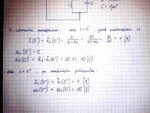piotrekn95
Junior Member level 3
Hello,
I am preparing for my circuit theory. I am trying now to solve a basic circuit like this :

I know that I could use Laplace theory to do it (with s symbol).
But unfortunately this circuit is too tricky for me to begin. I see that if we have DC input, the coil is like a wire, and there is no way through capacitor before switching the switch.

As far I circled only the values of voltage and current at the beginning (- before switching, +after switching), but can you help me what next step should i do to find the il(t).
Thank you
I am preparing for my circuit theory. I am trying now to solve a basic circuit like this :

I know that I could use Laplace theory to do it (with s symbol).
But unfortunately this circuit is too tricky for me to begin. I see that if we have DC input, the coil is like a wire, and there is no way through capacitor before switching the switch.

As far I circled only the values of voltage and current at the beginning (- before switching, +after switching), but can you help me what next step should i do to find the il(t).
Thank you